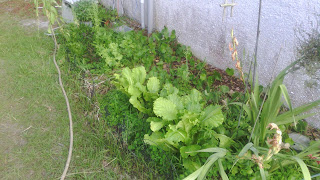Hello, again, my friends and followers!
So it looks like I get back a little quicker this time. Lack of energy is par for the course with Cushing's so it is a bit difficult to keep up with quite everything I would like to. That being said I haven't ignored my garden. Things are going slowly in part because of the continued cold spells which have reached down into the Eastern United States. I've seen YouTubers remarking about this unusual aspect of the weather this year and showing how to protect vulnerable plants from the cold snaps, which go well below freezing up in the North. My problem is that the temperatures are just low enough to slow growth down some. That means there are some harvests that will wait for the fall.
A friend purchased and had two mini greenhouses sent to me and I've put one to use for my shoots and seedlings. I'm going to have to wait to make some room in another place to set the other one up. The thing is I don't really want them in direct sunlight all the time because the UV rays break down the plastic covers and I can end up having to replace them every year. So I'll be keeping them in partial to indirect sunlight, which should be alright for my planned use of them anyway. I forgot to get a picture the other day of the greenhouse set up the other day. So we'll see if we can do that next time. However,
This is from inside the greenhouse and these two cups have Mellow Yellow Tomato seedlings in them. This is an acid-free variety which isn't easy to get but grow well in my climate and produce fruit abundantly. I'm growing them for the folks in the house who like the taste of tomatoes but whose stomachs don't handle the acid very well. They produce a medium to small tomato which is quite tasty, unlike most modern hybrids. They were developed in Southern Florida by a university down there. As you can see, they are doing quite well.
To the right are my dwarf Tiny Tim tomatoes planted with, in this case, Genovese Basil. As they grow I'll keep the basil pruned so it doesn't overgrow the tomato plant and we'll get the benefit of the companion planting along with some fresh basil from the pruning for use in the kitchen.
To the left is a volunteer Genovese Basil plant I'm happy to leave right there in the container it started up in. That container was given to me with a hybrid tomato plant in it the owner didn't have the time to take care of. This year, though, the basil popped up. So this container is taken, folks!
Believe it or not, I was looking for something in the closet and saw these poking up. I'd placed some sweet potatoes in the closet a couple of years ago and forgotten them. I'd been wondering how I was going to get some sweet potato plants to plant and there they were. So I placed them outside in some water, as you can see here. They are doing well and the leaves are greening and filling out. so they'll be ready to go soon.
One of my Aloe plants is flowering. And below that is the carrots in their container. I decided to harvest the carrots:
I know it's not much, but I've been trying to get some carrots to grow for years and this is the first success with the rainbow carrot seeds I was using. I've sown another kind among the brassicas and lettuce. They will serve a triple purpose if the Lord prospers my efforts. As for that bed:
I planted basil towards the border of the bed and that's what we can see coming up amongst the wood sorrel here. It looks like I'm getting the first germination from those.
But the basil isn't all that are starting to come up. So things are going if a little bit slow.
So that's it for now. I hope you are doing well with your gardening or that I can inspire you to take it up. It is something we all need to learn how to do and do well. So, as always:
Smile!





















































